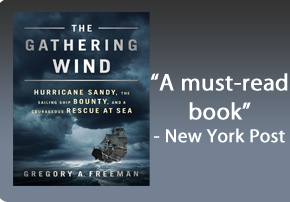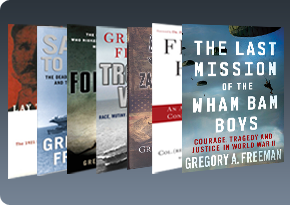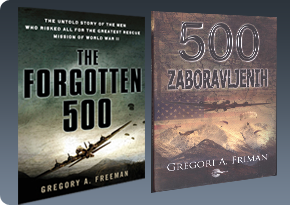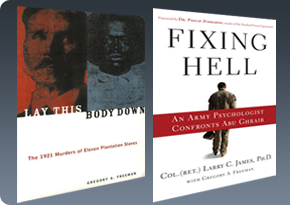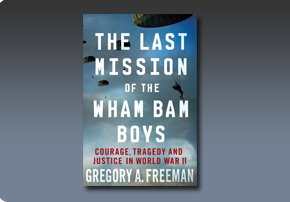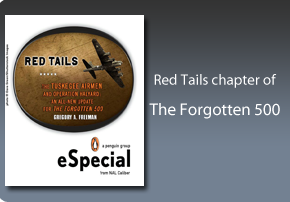
Frequently Asked Questions about
Gregory A. Freeman's Books
Answered by the Author
- Question: How can I get my book signed by the author?
- Hot topic Question: Did John McCain start the 1967 fire on the USS Forrestal?
- Question: Isn't there information indicating the rocket hit another plane on the Forrestal, not John McCain's?
- Question: What are you working on for your next books?
- Question: In Sailors to the End, why didn't you write (or write more) about a particular person?
- Question: Why don't you use military ranks or the right military terminology in your books?
- Question: I'm mentioned in one of the books but I wasn't interviewed by the author. Where did the information come from?
- Question: I was on the Forrestal and I remember something differently than what is in the book. What gives?
- Question: Did the Forrestal sail around South America or Africa?
- Question: Did you serve on the Forrestal?
- Question: How have the Forrestal vets responded to the book? How about the Operation Halyard vets?
- Question: Are the books available in paperback?
- Question: Will a movie be made from any of the books?
- Question: Have the Forrestal veterans benefited financially from the book?
- Question: Have you heard from the descendants of Clyde Manning or John Williams, the two main characters in Lay This Body Down?
- Question: What was the most interesting part of researching the Forrestal story?
- Question: I have an idea for a book or magazine article that I think Freeman would like. Should I contact him?
Question: How can I get my book signed by the author?
You can mail books to the author at Gregory A. Freeman, P.O. Box 680922 Marietta, GA 30068-9998. Please include a note about how you would like the book signed ("To Steve, Good luck in the Naval Academy") or indicate that you would like just the author's signature. Include a self-addressed return envelope or box with adequate return postage. Readers are welcome to send multiple books. You may wish to let the author know the book is in the mail by sending a note to author@gregoryafreeman.com.
Hot topic Question: Did John McCain start the 1967 fire on the USS Forrestal?
No.
The recent presidential race gave new life to some bad information about McCain and the Forrestal fire. As my book Sailors to the End explains in some detail, the fire actually was started by an unusual combination of electrical glitches and human errors by the flight deck crew, which resulted in a Zuni rocket being fired across the deck and into McCain's plane. Theories about a "wet start" and other possible causes were disproven soon after the fire. McCain was never suspected of causing the fire because investigators determined immediately that the rocket misfired from the other side of the flight deck. (The pilot of that plane also was not at fault.)
The real culprit in the 134 deaths on the Forrestal was the Navy's decision to supply the carrier with very old, unstable bombs that exploded on the flight deck once the fire started. Bombs typical for 1967 would have withstood the fire long enough for the crew to put out the blaze, but the old bombs blew up almost immediately and turned what could have been a manageable fire into a disaster.
Some detractors are citing the Forrestal fire as an example of McCain's supposedly reckless behavior or poor performance as a pilot, but the facts do not support this conclusion. Regardless of what kind of pilot McCain was, on this day he was essentially a bystander to the cause of the fire, just like all the other pilots. He didn't cause it and he narrowly escaped death by jumping out of his plane as it was engulfed in fire. Once on the flight deck, McCain was injured when a 1,000-lb. bomb exploded. He then went below decks and assisted the crew with the difficult task of throwing bombs overboard to prevent them from blowing up in the fire. Afterward, he went to the pilots' ready room.
McCain did nothing inappropriate on July 29, 1967. While he is the first to say that credit for the heroic actions on the Forrestal that day should go to the ship's crew, McCain responded properly and admirably, as any Navy pilot would in such a crisis.
Parts of the Navy's report indicate that the the rocket hit the plane of Fred White, another pilot near John McCain, but there is ample evidence to suggest that the report is in error. Multiple eyewitnesses and the film footage of the fire indicate that the rocket hit McCain's plane. Senator McCain has stated repeatedly, and in his own book, that he felt the rocket hit his plane. It is conceivable that the rocket hit both planes, with either glancing blows or direct impacts. (The rocket continued on and splashed in the ocean, rather than stopping once it hit a plane.) The planes were damaged so much in the fires that there was no hard evidence left to show where the rocket made contact. Exactly which plane the rocket hit was not a major focus of the Navy report, and the Navy's investigation contains other errors, so the discrepancy is only mildly surprising. There is room for legitimate disagreement on this particular point, but my conclusion is that the rocket hit McCain's plane, and possibly White's plane also.
In the course of writing Sailors to the End, I came across many instances in which sources conflicted over details and I had to weigh the evidence to decide which to use in the narrative. In this case, I find the evidence convincing that the rocket hit McCain's plane.
But really, I just don't think it makes any difference. Even if one accepts the idea that the rocket did not hit McCain's plane but hit White's plane and that caused McCain's fuel tank to rupture, that is little more than a detail that changes nothing about the Forrestal story or McCain's experience that day. McCain's experience on the Forrestal would have been exactly the same whether the rocket hit his plane or the one next to him. Either way, McCain's fuel tank ruptured and he was surrounded by fire. Anyone who thinks that McCain or his supporters would falsely claim the rocket hit his plane in order to bolster his military record is really grasping at straws. There's no glory in having your plane hit by an errant rocket, and the rest of McCain's experience that day is undisputed. Which plane was hit by the rocket is just a minor detail that changes nothing. So did the rocket hit McCain's or White's plane? I think McCain's, but I can't get worked up about arguing the point either way.
Question: What are you working on for your next books?
I am working on several military projects right now, including the story of Jesse Brown, the first black naval aviator and Thomas Hudner, a Medal of Honor recipient.
Question: In Sailors to the End, why didn't you write (or write more) about a particular person?
There were so many people on board the Forrestal during the fire -- more than 5,000 -- that it was impossible to tell everyone's story. It was not possible even to tell the stories of all those who were directly and significantly involved in the fire event. I could have written volumes about the Forrestal and this tragedy, but the book format restricted me to telling the stories of about a dozen people. I tried to mix in a variety of people so that the book gave a glimpse into what happened to everyone on board. If you or a loved one is not mentioned or not addressed in full, it was just a matter of space constraints or whether I heard of a veteran's story in time to include it. To this day, I keep hearing more stories from the Forrestal fire that I wish I could have included in the book but I just didn't hear them in time.
Question: Why don't you use military ranks or the right military terminology in your books?
I intentionally avoid military jargon so that the stories will be accessible to a broad audience, not just those who served in the military. One goal of writing these books was to bring this story to the attention of the general public, so I tried hard to write them in a way that anyone could understand. Unfortunately, that can mean leaving out some specifics and glossing over some information that veterans would describe differently. If the books were written only for veterans or military experts, I would have written them very differently and included so much military terminology and detail that the average reader would be confused and lose interest.
I conducted extensive interviews with dozens of veterans and others while researching each book, but not with every single person mentioned. The sheer number of men on the Forrestal, for instance, precluded talking with everyone. For some individuals whose stories were relatively brief in the context of the book, or those who were not available for interviews, I relied on historical records that document what happened to them. In the case of the Forrestal story, I relied on records collected by the Forrestal veterans association, some that came directly from the Navy, and some contemporaneous accounts in the news media. Often, those records included first person reports from the veterans in which they documented their experiences and emotions soon after the fire.
In researching this story, I often came across conflicting accounts of what happened that day. One of my jobs as the author was to sort through those different versions of what happened and see if there was any reason to believe one over the other. Sometimes there would be an objective, reliable source that could settle the issue, but sometimes I had to just weigh the evidence and go with the version that seemed most plausible to me. I've done my best to portray the story accurately.
Question: Did the Forrestal sail around South America or Africa?
The Forrestal sailed around Africa. In the first edition of the book, there is an erroneous mention of the Forrestal going around South America on the way to Vietnam. This is the result of a last minute correction that was not proofread as closely as it should have been. This error and a couple of others (all minor and not affecting the overall story) have been corrected in subsequent printings.
Question: Did you serve on the Forrestal?
No, I was three years old in 1967. I never served in the Navy and did not have any personal connection to the story when I first started researching the book. I approached the Forrestal story as a journalist, but I was soon drawn into the personal lives of the men who served that day and felt a strong desire to tell their story effectively and compassionately.
Question: How have the Forrestal vets responded to the book?
The response of the Forrestal vets has been extremely positive, and that is very rewarding to me. The Operation Halyard vets also have been quite positive about the book and thankful to have the story finally told.
Question: Are the books available in paperback or e-books?
Yes, The Last Mission of the Wham Bam Boys, Lay This Body Down, Sailors to the End, and The Forgotten 500 are available in hardcover, mass market paperback and trade paperback. Most of the books are available in e-book form for Kindle, Nook, and other readers. The additional chapter to The Forgotten 500 and Red Tails are only available as an E-chapter.
Question: Will a movie be made from any of the books?
Folks in Hollywood are currently working on movies for Sailors to the End, Lay This Body Down, and The Forgotten 500, but those projects are in the preliminary stages. It often takes years for a book to become a movie, if ever.
Question: Have the Forrestal veterans benefited financially from the book?
The author donated a substantial portion of the book's profits to the effort to create a USS Forrestal museum.
Yes. Though I could not find them before the book was published, they did find me once they heard about the book. Some of Williams' descendants appreciate the accurate telling of the story, though it is difficult for them to read about this difficult part of their family history. Other members of the Williams family are less appreciative and wish I'd never revealed this story. Descendants of Clyde Manning tell me this is the first time they have heard the full story of what happened in 1921, though a sketchy version of the events had been passed down in their family. They have thanked me for telling the story.
Question: What was the most interesting part of researching the Forrestal story?
The whole process was very interesting in different ways, but the coolest part was when I visited the USS Harry S Truman at sea. The Truman is one of the Navy's newest and biggest aircraft carriers, and I was able to spend a couple days on board to see carrier life first hand. Landing on the carrier (we missed the first time) and then being launched off the ship the next day was a real kick.
Sure. I'm always happy to hear a good story. You can contact me at Gregory A. Freeman, P.O. Box 680922 Marietta, GA 30068-9998. Or you can e-mail me at author@gregoryafreeman.com.
Latest News
Forgotten 500 list of rescued airmen has been updated!
The list of airmen rescued in Operation Halyard that was included in THE FORGOTTEN 500 was known to be incomplete, and many people have asked if their family members might have been rescued even though they weren’t on the list. Now we have an updated list, thanks to the great research by Wendy Irwin, a relative of one of the men rescued.
Using the Missing Air Crew Reports that were filed after a bomber went down, Wendy has added a number of crew members who most likely were sheltered by Draja Mihailovich and rescued in the Operation Halyard flights. We still can’t call the list complete, so your relative might have been part of Operation Halyard even if his name isn’t included. But this is a great addition to the Forgotten 500 canon and I hope it answers important questions for some families.
See the updated list here. Order your copy of THE FORGOTTEN 500 here.
THE FORGOTTEN 500 now available in Italian!
The story of Operation Halyard and rescue of airmen in World War II is now available in an Italian translation. This follows the Serbian translation that was released a few years ago. The Italian version is I 500 SOPRAVVISSUTI and is available here.
The Gathering Wind is coming on October 29!
On the one-year anniversary of the loss of the great sailing ship Bounty in Hurricane Sandy, I will release The Gathering Wind: Hurricane Sandy, the Sailing Ship Bounty, and a Courageous Rescue at Sea.
Based on interviews with Bounty survivors and unfettered access to Coast Guard rescue team members, The Gathering Wind offers not only the first, but the most complete account of this heartbreaking, thrilling, and inspirational story. Why in the world was an old wooden ship sailing directly into a hurricane? Why did the crew go along with the captain’s decision? This book will tell you.
I was honored to get to know the Bounty survivors and the rescuers who willingly flew into one of the worst hurricanes in history. Their story will have your attention from the first page to the last.
Red Tails: The Forgotten 500 chapter now released
Red Tails tells the story of the Tuskegee Airmen, the first black pilots in WWII, who saved the lives of 500 Americans. This E-chapter of The Forgotten 500 can be found at Barnes and Noble
New book available now!
The Last Mission of the Wham Bam Boys tells the little known story of an American bomber crew, all young men with families waiting for them back home, and their fateful mission in the last days of World War II. Click here to order The Last Mission of the Wham Bam Boys!....Click Here
Red Tails: A new E-chapter for The Forgotten 500
A new chapter will soon be available for everyone who loved the story in The Forgotten 500. Titled Red Tails, this chapter tells of the previously unknown contribution of the famed Tuskegee Airmen, the first black pilots in World War II, to the rescue of more than 500 American airmen behind enemy lines. The new chapter will be available as an e-book download and includes a summary of the entire story told in The Forgotten 500. Watch this site for information on how to order Red Tails.
Read The Forgotten 500 in Serbian
The Serbian translation of The Forgotten 500 is on sale in Serbia and can be ordered in the U.S. The title is 500 Zaboravljenih by Gregori A. Friman.
To order, send an e-mail to Marko at marko@evro-giunti.com and he will arrange the purchase and shipment.
Facebook and Twitter
Friends on Facebook and Twitter receive all the
latest news on books, appearances, and other opportunities.


Amazon.com Author Page
Go here to find all of Gregory A. Freeman's books and more about the author: Gregory A. Freeman on Amazon.com
Reader Reviews
"A re-creation of the first war crimes trial after World War II… a history making trial, setting the tone for Nuremberg. A chilling tale .. [and] a riveting narrative." — Kirkus Reviews
"Freeman has once again crafted a gripping, cinematic narrative – one that raises important questions about justice and morality in a time of industrial annihilation of civilian populations. A timely and riveting story of heroism and horror."— Alex Kershaw, best selling author of The Longest Winter and The Bedford Boys
"With The Last Mission of the Wham Bam Boys, Gregory A. Freeman delivers a thorough, artful, and absolutely riveting account of a fascinating yet tragic story of war, humanity, and justice. Freeman again proves that he ranks among today's finest historical storytellers."— Alvin Townley, author of Fly Navy and Legacy of Honor



